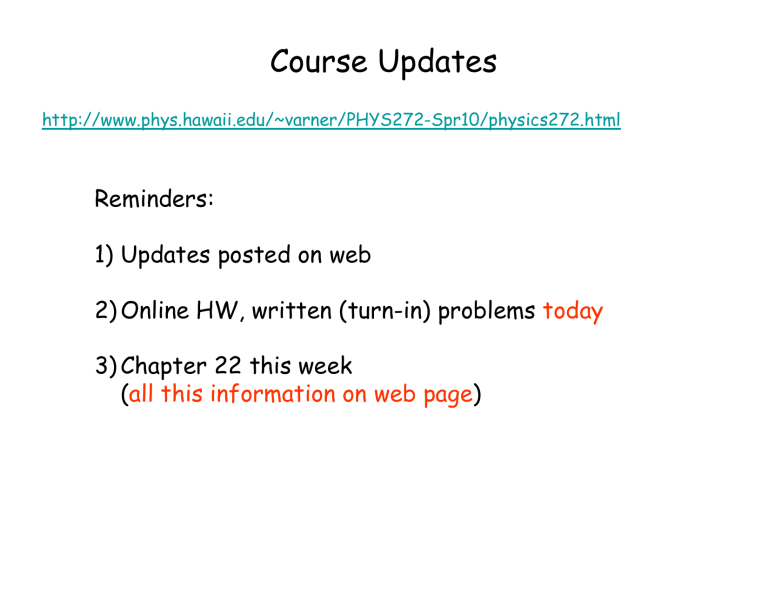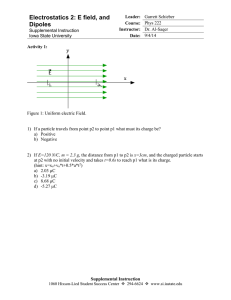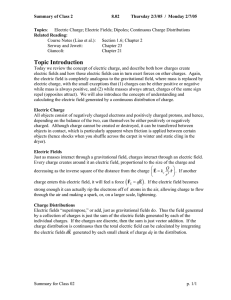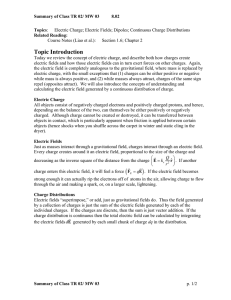Lecture 4
advertisement

Course Updates http://www.phys.hawaii.edu/~varner/PHYS272-Spr10/physics272.html Reminders: 1) Updates posted on web 2) Online HW, written (turn-in) problems today 3) Chapter 22 this week (all this information on web page) Lecture 4 Hints for 21.23 Q L L Q L' = L2 + L2 = 2 L L kQ 2 / L2 Q L Project both contributions from 2 +4 on the diagonal. 2 2 kQ / L Q kQ 2 / L'2 Don’t forget the force is a vector !!! 2 Lecture 4 Hints for 21.74 T θ θ L q,m T mg L d Balance forces in the vertical direction Balance forces in the horizontal direction Relate θ to d and L Tcosθ sinθ=(d/2)/L q,m Tcosθ=kq2/d2 Tsinθ=kq2/d2 3 Lecture 4 Hints for HWK -σ Region I σ Region II Region III 4 Review What if we have a distribution of charge? Q – charge of distribution. Q dq – element of charge. dE – contribution to E due to dq. Can write dq = ρ dV; ρ is the charge density. r E= 1 4πε 0 ∑ i dq r r r̂ r dE Lecture 4 Continuous Charge Distributions P dV qi 1 1 dq ρ dV ˆ ˆ rˆ → r = r 2 i 2 2 4πε 0 V∫ r 4πε 0 V∫ r ri 1. Can use calculus to determine electric fields for a few special charge distributions. 2. Method important. Know how to do. 3. For most problems, we cannot solve them analytically, but we can solve using computer methods. 5 Consider the E-field of a positive point charge at the origin vector map Lecture 4 Ways to Visualize the E Field field lines + chg + chg + + Introduced by Michael Faraday (1791-1867) 6 Lecture 4 Rules for Vector Maps + chg + • Direction of arrows indicates the direction of the field at each point in space • Length of arrows is proportional to the magnitude of the field at each point in space 7 Rules for Field Lines + graphical “trick” for visualizing E fields - • Lines leave (+) charges and return to (-) charges • Number of lines leaving/entering charge ∝ amount of charge • Field lines never cross → Tangent of line = direction of E at each point → Local density of field lines ~ magnitude of E at each point Lecture 4 Exercise1: 6) A negative charge is placed in a region of electric field as shown in the picture. Which way does it move ? a) up b) down c) left d) right e) it doesn't move 9 Lecture 4 Exercise1: 6) A negative charge is placed in a region of electric field as shown in the picture. Which way does it move ? a) up b) down c) left d) right e) it doesn't move 10 Lecture 4 Exercise2: y •Consider a dipole (2 separated equal and opposite charges) with the y-axis as shown. -Which of the following statements about Ex(2a,a) is true? (a) Ex(2a,a) < 0 (b) Ex(2a,a) = 0 +Q a a a 2a x -Q (c) Ex(2a,a) > 0 11 Lecture 4 Exercise2: y •Consider a dipole (2 separated equal and opposite charges) with the y-axis as shown. -Which of the following statements about Ex(2a,a) is true? (a) Ex(2a,a) < 0 (b) Ex(2a,a) = 0 +Q a a a 2a x -Q (c) Ex(2a,a) > 0 Solution: Draw some field lines according to our rules. Ex 12 y Lecture 4 The Electric Dipole +q a θ a -q r E x E What is the E-field generated by this arrangement of charges? Calculate for a point along x-axis: (x, 0) Ex = ?? Ey = ?? Symmetry 1 q E y ( x, 0 ) = −2 sin θ 2 4πε 0 r a sin θ = r Ex(x,0) = 0 E y ( x , 0 ) = −2 r2 = x2 + a2 1 qa 4πε 0 ( x 2 + a 2 )3 / 2 13 Lecture 4 Electric Dipole Field Lines • Lines leave positive charge and return to negative charge • Field largest in space between two charges • We derived: Ey ( x,0 ) = −2 1 qa 4πε 0 ( x 2 + a 2 )3/ 2 ... for r >> a, 1 E y ( x ,0 ) ∝ 3 x 14 Lecture 4 Field Lines From Two Like Charges • There is a zero halfway between the two charges • r >> a: looks like the field of point charge (+2q) at origin 15 Example 3: •Examine the electric field lines produced by the charges in this figure. •Which statement is true? q1 q2 (a) q1 and q2 have the same sign (b) q1 and q2 have the opposite signs and q1 > q2 (c) q1 and q2 have the opposite signs and q1 < q2 Example 3: •Examine the electric field lines produced by the charges in this figure. •Which statement is true? q1 q2 (a) q1 and q2 have the same sign (b) q1 and q2 have the opposite signs and q1 > q2 (c) q1 and q2 have the opposite signs and q1 < q2 Field lines start from q2 and terminate on q1. This means q2 is positive; q1 is negative; so, … not (a) Now, which one is bigger? Notice along a line of symmetry between the two, that the E-field still has a positive y component. If they were equal, it would be zero; This indicates that q2 is greater than q1 Molecules can have a permanent dipole moment. Called polar molecules. example: H2O r r p = qd Dipole moment: d -q Lecture 4 Electric Dipoles + + - +q ideal dipole P What happens to a dipole in a uniform electric field? d -q +q E P 18 Molecules can have a permanent dipole moment. Called polar molecules. example: H2O r r p = qd Dipole moment: d -q Lecture 4 Electric Dipoles + + - +q ideal dipole P What happens to a dipole in a uniform electric field? d F- -q +q θ F+ P can write as: r r τ = p× E r E No net force; but torque. torque = Fd sin θ = qEd sin θ = pE sin θ Cross product 19 A dipole in a nonuniform electric field will experience a force. Lecture 4 Electric Dipoles Microwave ovens: dipole moment of water used to cook food. •Microwave frequency at natural frequency of vibration E of water. •Molecules resonate with the rapidly oscillating electric field and absorb a large amount of energy. •The KE of the excited molecules is converted to thermal energy by collisions of the molecules. Non polar molecules: no permanent dipole moment, but an electric field can cause an induced dipole moment by causing charge separation. Molecules are polarized. E + + + + + + + 20 A B C D Lecture 4 Which of the following field line pictures best represents the electric field from two charges that have the same sign but different magnitudes? 21 A B C D Investigate with simulation: Lecture 4 Which of the following field line pictures best represents the electric field from two charges that have the same sign but different magnitudes? 22 Lecture 4 Electric Flux “Counts Field Lines” r r Φ S = ∫ E ⋅ dA S Flux through surface S r r Integral of E ⋅ dA on surface S 23 Lecture 4 For next time • Quiz on Friday • Coulomb’s Law, Electric Fields • Office Hours usually after this class (9:30 – 10:00) in WAT214 – not today (1-1:30pm) • Turn in HW #1 (Hand In), HW #2 available 24



